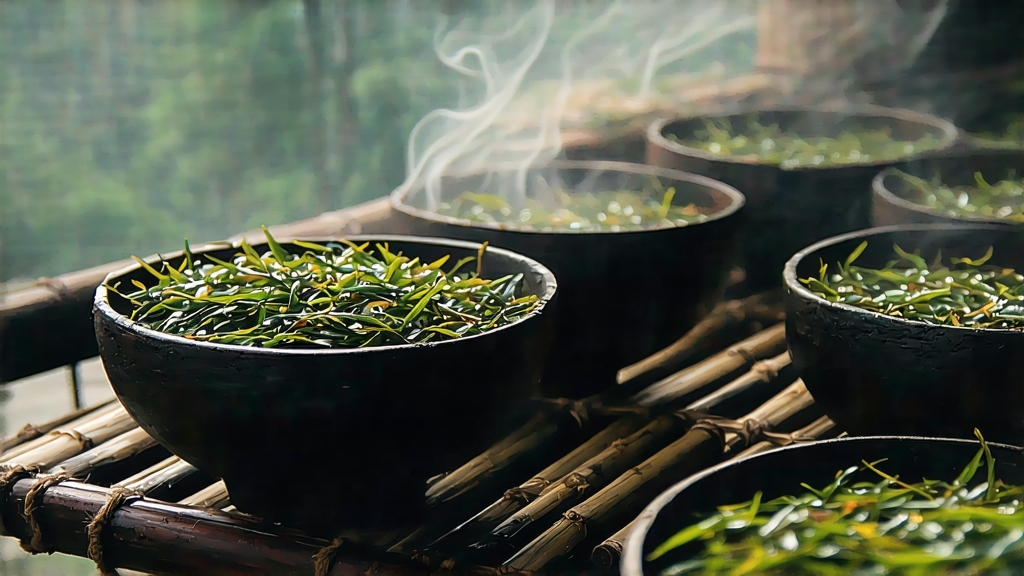
Ask most tea lovers to name China’s iconic black teas and Keemun or Yunnan Gold spring to mind, yet the very first black tea ever created—long before these celebrated cousins—was Lapsang Souchong. Born in the cool, mineral-rich folds of the Wuyi Mountains in northern Fujian, this smoke-kissed leaf is the progenitor of the entire black-tea family, a living time capsule of Ming-dynasty ingenuity that still travels the world in trunks of musky aroma.
1. Historical roots
Local legend fixes the birth year around 1568, when a passing army requisitioned tea baskets during the late-spring harvest. To hasten drying and prevent spoilage, villagers spread the leaves over pine fires; the resulting fragrant cargo found eager buyers among Dutch traders in Xiamen. By the early 1600s “bohea” (the Min-dialect rendering of Wuyi) had become a luxury item in Amsterdam and London, priced higher than silver and inspiring the English habit of tea with milk and sugar. The name “Lapsang” is derived from the Fuzhou pronunciation “la” (pine) and “sang” (wood), while “Souchong” refers to the fourth and fifth leaves plucked lower on the bush—older, broader, and more cellulose-rich, ideal for absorbing smoke.
2. Terroir and cultivar
Authentic Lapsang Souchong hails from Tongmu Guan, a protected enclave inside the Wuyi National Nature Reserve where the altitude climbs quickly from 600 m to 1 400 m, the soil is a well-drained, sandy laterite strewn with weathered tuff, and a subtropical monsoon climate keeps humidity above 80 %. The indigenous cultivar is Xiao Ye Zhong (“small-leaf species”), a slow-growing shrub whose thick, waxy cuticle traps aromatic precursors that intensify under cool night temperatures. Within Tongmu, micro-valleys such as Guadun, Mashi, and Miaowan yield subtly different leaf chemistry; Guadun is prized for a sweeter, longan-fruit note, while Mashi delivers the most penetrating pine resonance.
3. Harvest calendar
Plucking begins around the Qingming festival (early April) and continues in flushes until early June. Only one bud with two or three leaves is taken, never the coarse, fully-mature blades that cheaper imitation versions rely on. Morning plucking ends by 10 a.m. so that dew-weight does not exceed 5 %, ensuring consistent withering.
4. Traditional craft: the pine-smoke journey
The transformation unfolds in an eight-step choreography performed entirely by hand inside dark, cedar-plank lofts whose rafters are blackened by decades of resinous smoke.
Withering – Fresh leaves are laid on bamboo screens suspended over shallow trenches of smouldering pine embers (Pinus massoniana) for 6–8 h; temperature hovers at 28 °C, coaxing moisture down to 55 % while the leaf inhales its first whisper of smoke.
Rolling – Once the leaves turn velvety and cool, they are rolled for 45 min in small batches inside a cast-iron wok set at 60 °C. The goal is to rupture 70 % of cell walls without macerating the blade, releasing polyphenol oxidase.
Fermentation (oxidation) – The rolled leaf is piled in pine-wood crates lined with damp cloth and left for 3–4 h in a chamber kept at 24 °C and 90 % humidity. Oxidation proceeds rapidly; the leaf shifts from olive to copper, then to a dark mahogany while developing malty, fruity aromatics.
Primary drying (Hongbei) – A charcoal brazier topped with a bamboo sieve brings the leaf temperature to 80 °C for 20 min, arresting oxidation at 90 % and locking in a crimson infusion colour.
Smoking (Songxun) – The signature act: the semi-dried tea is transferred to a lower loft where pinewood slabs and pine-root knots smoulder at 40–50 °C for 6–8 h. Artisans shuffle the leaves every 20 min so that each curl absorbs smoke evenly; the process may be repeated on consecutive nights until the master taster detects the desired balance of